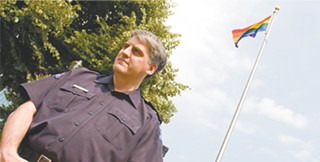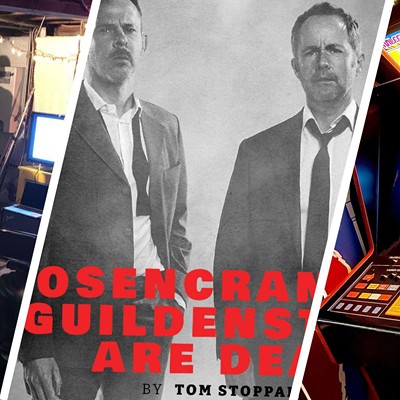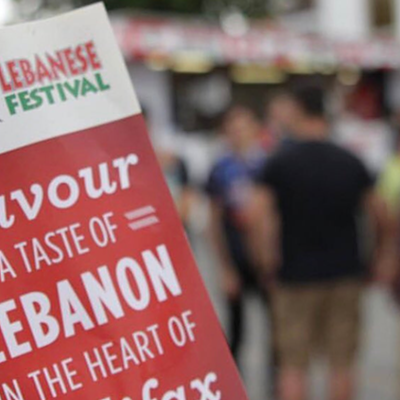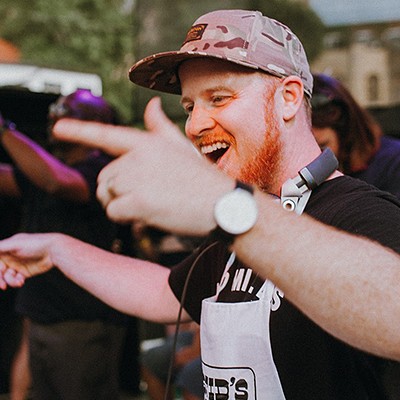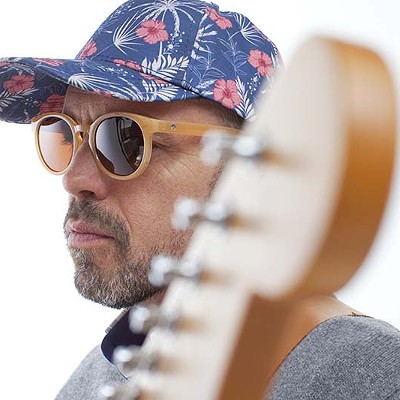Through the ribbon of glass running along one wall in Halifax Regional Police chief Frank Beazley's office, a rainbow flag is visible, draped on an apartment balcony. The icon sits perfectly off the shoulder of deputy chief Chris McNeil, who's borrowing his boss's office while he's away. Dressed casually, a blue HRP pin on the lapel of his blazer, McNeil has sunk into a wing-backed chair.
McNeil's repose is a marked contrast to Friday May 11, when, in full uniform, he made a rare public announcement following the murders of both Michael Paul Knott, 44, and Trevor Charles Brewster, 45, in the space of a week.
"We are issuing a public advisory about potential safety concerns in cruising areas," McNeil announced at the press conference. "We are taking this unusual step to ensure individuals protect themselves in certain areas."
The step was unusual and necessary, McNeil maintains two months on. "It became relatively clear that we had to warn the gay community, particularly the segment of the community that was involved in cruising.
"I have the responsibility of providing people with information which they can use to protect themselves."
The first challenge, he says, was to get the language right. "They needed to hear that we were concerned about their safety. How do you say that? So we asked."
Specifically, HRP asked the Nova Scotia Rainbow Action Project to find the right way to say it and, at the same time, help give the community a heads-up that they would be saying it.
Kevin Kindred, chair of NSRAP, confirms his group was contacted and "reviewed the draft language" with police to ensure clarity—that those "frequenting cruising areas" were reached—and sensitivity prior to the announcement. "They worked with us to make sure the message was well-tailored," he says.
Overall Kindred credits police for their cooperation with diverse communities. In fact, Kindred didn't hear any criticism of the police's announcement, but heard plenty about the media's sensational take on the crimes. He was a guest on a TV news segment that was introduced with talk of a "serial killer."
Deputy chief McNeil sees cruising as no different than two people meeting in a bar and going home together. "I have twentysomething children who regularly go downtown. What if this had been somebody going downtown and leaving a bar with somebody—and they were heterosexual? Equally I would've been criticized for saying "If you go downtown and you meet somebody....'
"Our job isn't to judge that particular choice. We didn't come out and say "Don't cruise.'"
Outside of the two tragic killings, HRP is in bridge-building mode with the gay community, McNeil says. One of the main pillars of that effort comes through the work of detective-constable Debbie Carleton, who sits across the room from the deputy chief. In addition to her "regular police duties" as a member of the General Investigations Division, Carleton volunteers—this is an unofficial position at present—as HRP liaison with the gay community.
Prior to the announcement, Carleton says, she was in touch with various contacts in the community who allowed her to deliver the information "without being invasive."
Though she doesn't have scheduled hours assigned to her liaison work, Carleton says "I try to connect with business owners and The Youth Project...just trying to open up communication with the community so they feel comfortable with us as a police organization. Hopefully things that need to be reported are reported and they feel comfortable to do that.
"It takes time to build that trust."
Joining the force in 1995, Carleton has worked to build stronger ties with the gay community going back several years. According to deputy chief McNeil, it was Carleton's efforts that led to HRP marching in the parade last year. This year Carleton is the force's parade marshal. The contingent includes members from Victims Services, Youth Programs, patrol officers on horseback and the HRP mascot, McGruff. Chief Beazley is set to address the crowd at the Common, where the parade winds up. Last year nine or 10 officers marched, she says, and she hopes to beat that number this year. She was about to send out the internal email urging officers and staff to walk.
Her ultimate goal for all this: the assurance that anyone—no matter their sexual orientation—can make contact with police, "whether it's coming to me, calling it in anonymously or dealing with one of our other officers, that they'll be treated with respect."
This has not always been—nor is it always now—the case.
At The Youth Project offices, located about a 10-minute walk north on Brunswick from HRP headquarters, a small assembly line led by Sheena Jamieson (summer staff member and a gender studies student at King's) screen-prints a skull-and-bones onto construction-paper hats. The 22-foot-long parade float commandeered by The Youth Project this year will have a pirate theme.
"I think the number one issue with LGBT youth and police is trust," Jamieson comments, combing the white paint over the screen. "We have a lot of incidents where they don't trust police so they don't report something. Or they could report something completely unrelated to sexual orientation and sexual orientation becomes a factor."
Asked for an example, Jamieson offers this: "We had a youth who had a lost purse and she was reporting this purse and this police officer launched into this tirade about her because she was a lesbian. And that was unfortunate.
"On the other hand you do have the beat cops in the north end and they do drop by The Youth Project to familiarize themselves with it. And we do have allies in the police force."
Though the public advisory about the two murders did register among The Youth Project's constituency—people under 25 across Nova Scotia whom the non-profit group helps with education and social support services—according to Jamieson, "It doesn't affect us as much as the older queer community. It influenced them as much as it was this big thing that rippled through the community."
Jamieson observed discussion on Facebook groups about the murders and the idea of safety as related to cruising. Some said they were going to be more careful, Jamieson says. "It was a lot more open than I expected people to be."
Still, she maintains, the public safety issue for young people in the queer community differs from their older counterparts. "Personal safety on the street, walking at night or being visibly identified and then hurt because of perceived sexual orientation or gender identity. That's probably one of the biggest issues. Whether they're holding their partners' hand or walking alone, their perceived sexual orientation or gender identity becomes an issue and people will target that.
"They come in with stories all the time about how they're just walking down the street and they become a target. And they don't know it's coming."
By the time they come in to the Youth Project offices, which Jamieson says is a "safe place" for queer youth, they'll have made up their minds about reporting to the police—some will, some won't.
Police officers McNeil and Carleton both nod, recognizing that the bridge isn't complete yet.
McNeil urges youth or adults to test their faith in their community's police force. "Our message is "you need to come forward.' We will safeguard your information to the extent that we can. There are all sorts of decisions about whether or not you prosecute or don't prosecute."
He knows some people haven't publicly come out yet, or have and don't want to make an issue of their sexual orientation. But, he says, it could become a difficulty for police. "One of the concerns during the Brewster homicide was there was an assault that we weren't aware of—that somebody didn't come forward." And that assault, the thinking went at the time, could've escalated to murder.
As for the youth who faced the officer's tirade, McNeil says, "I'm sure there are officers that show prejudice and discrimination as shown in every segment of society. I'd be naive to think that we didn't have that."
McNeil credits Carleton with encouraging acceptance among the ranks. She remains more modest, mentioning she'd like to see a fulltime liaison position get created and that the existence of an internal Diversity Action Team—including uniformed patrol cops, plain clothes detectives and some civilians—has helped as well.
The issues, she says, go far beyond public safety and cruising. "There are all different aspects of the gay community as well. It's not just gay men. It's not just cruising. Not all gay men cruise. Not all men that cruise are gay."
McNeil agrees, adding: "Spectacle Lake has been a concern for the community for some time—how cruising type behaviour is impacting the broader community there. When we were originally dealing with trying to manage the concerns around that, that was the beginning of a relationship."
Adds Carleton: "I would hope that all officers would leave their biases away from the job and just present themselves as representatives of HRP and deal with that person equally no matter what their differences are. That's my goal; that's what I would like to see."
Sean Flinn is a freelance journalist in Halifax.

